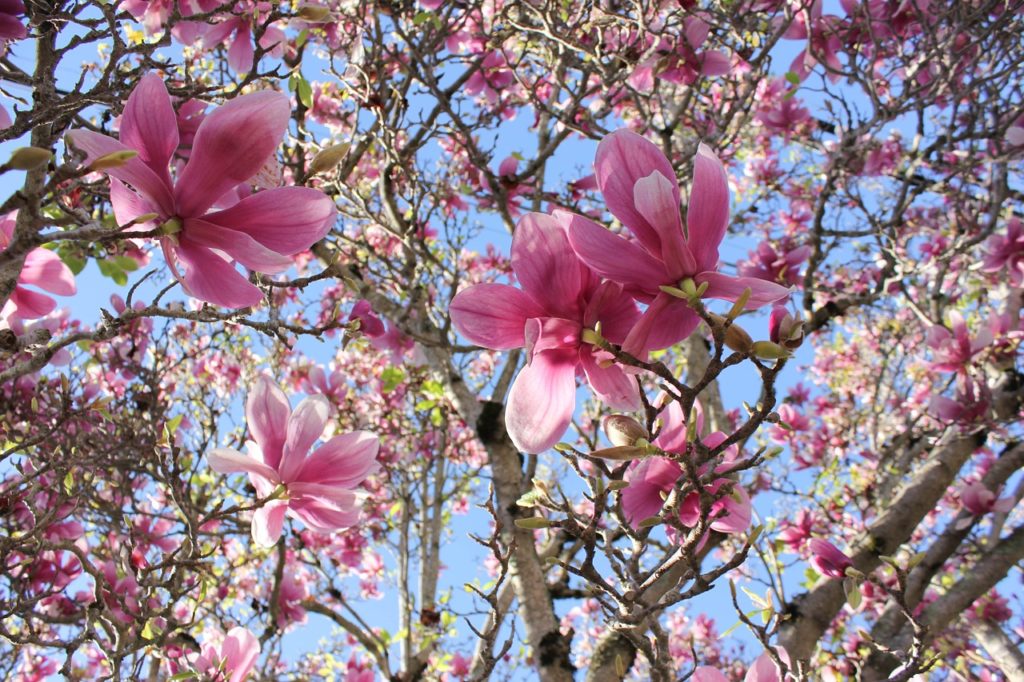This is the second half of a two part series on saucer magnolia. The following examines the cultivation of the tree, as well as its damaging agents and pests, allergenic potential, and various uses.
Introduction
Saucer magnolia (Magnolia x soulangiana) is a deciduous hybrid magnolia. It is derived from Yulan magnolia (Magnolia denudata) and lily magnolia (Magnolia liliiflora). Saucer magnolia is considered a small tree, or large spreading shrub. The plant is named for its distinctive wide, saucer-like flowers. It was first cultivated in 1826 by French horticulturist Etienne Soulange-Bodin. The plant entered cultivation in England, becoming popular there before being adopted in other parts of Europe, as well as North America. Saucer magnolia has since become the most popular deciduous magnolia used in cultivation.
Cultivation
Saucer magnolia is a popular selection for cultivation. Numerous cultivars have been developed. They are differentiated by growth habit, leaf color, and flower color. The cultivars feature flowers in various shades of white, pink, rose, purple, magenta, and burgundy. The most frequently selected varieties include ‘Alexandrina’, ‘Brozzoni’, ‘Grace McDade’, ‘Jon Jon’, ‘Lennei’, ‘Lennei Alba’, ‘Lilluputian’, ‘Rustica Rubra’, ‘Spectabilis’, and ‘Verbanica’.
Damaging Agents and Pests
Saucer magnolia is afflicted by several diseases. It is subject to various leaf spots, which are caused by bacterial or fungal infections. The fungi inhibit branch growth, and cause the infected bark to slough off. Cankers that form as a result of these infections can result in significant branch dieback. Enlarged cankers can distort the plant’s form, creating a malformed appearance. Consistent fertilization, and watering during extended periods of drought prevents canker formation.
Saucer magnolia is susceptible to verticilium wilt, which may kill the branches. If the disease becomes pervasive, it can culminate in plant mortality. Saucer magnolia may be infected by powdery mildew, a fungal disease that causes blisters to form on developing leaves. Infected leaves become laden with a white to gray powdery growth. The leaves of severely infected plants often turn brown, and drop prematurely.
Saucer magnolia can be afflicted by phytophthora, a root disease. When infected, magnolia roots proceed to rot, which inhibits the plant’s ability to absorb water and nutrients. This causes the plant to decline rapidly. Wood rot is another fungal disease that affects saucer magnolia. When infected, the plant’s wood starts to decay. The wood rot fungus generally invades the plant through scars and wounds. Wood rot can be recognized by the formation of conks or fruiting fungal bodies that appear on the trunks of infected plants. Wood rot is more widespread in older plants. The disease causes a loss in plant vigor, and can eventually result in plant mortality. Chlorosis is common during spring. This disease affects the expanding leaves, preventing infected plants from absorbing vital nutrients.
Saucer magnolia is vulnerable to infestation from aphids, scales, and spider mites. Magnolia scale (Neolecanium cornuparvum) frequently attacks the species. Magnolia scale is a small brown insect that infiltrates the plant’s vascular system, and feeds on the sap. Severe infestations can cause branch dieback. As the insect feeds, it excretes a sticky substance called honeydew, which blackens with sooty mold over time. Infested branches often turn black from the abundance of excrement produced by the ravenous insects. Black sooty mold can impede the photosynthetic process of magnolia trees, stifiling their growth. Continuous infestation by magnolia scale can result in plant mortality.
Leafminers are occasionally attracted to saucer magnolia. They gnaw on the leaves, and flowers, often stunting new growth. Leafminers occur most frequently in the southern United States. The aroma of the plant’s flowers may attract a multitude of beetles. Beetles feed on the rich pollen contained within the flowers. Japanese beetle is the most common species found on saucer magnolia. Saucer magnolia has a tendency to lose blooms to late spring frosts.
Allergenic Potential
Saucer magnolia is classified as a moderate allergen.
Uses
Saucer magnolia is used for numerous purposes. Due to its striking dark green foliage, and appealing floral display, saucer magnolia is often selected for planting in landscape settings. It adds beauty and variety to mixed shrub borders. It also makes for an excellent shade tree. The plant’s relatively compact size enables it to be used as a container tree. When grown in this fashion, saucer magnolia requires consistent watering, and at least eight hours of sunlight each day. Container trees should be fed with an acidic fertilizer at least once a month. Saucer magnolia can be trained as an espalier plant, where it grows against a flat wall or fence. It may also be trained to resemble specific shapes. Training and pruning is an ongoing practice. Pruning of saucer magnolia should be avoided in summer. Pruning cuts administered during this period can increase the potential for bacterial and fungal infections.
When removed, and reduced to logs, saucer magnolia wood can be used to construct cabinets, and other furniture. The wood has also been used in the production of paper. Saucer magnolia is utilized as a nesting site for squirrels, and birds. Many birds consume the seeds. The sprouts of young trees are browsed by rabbits, and deer. Rabbits also feed on the bark.


